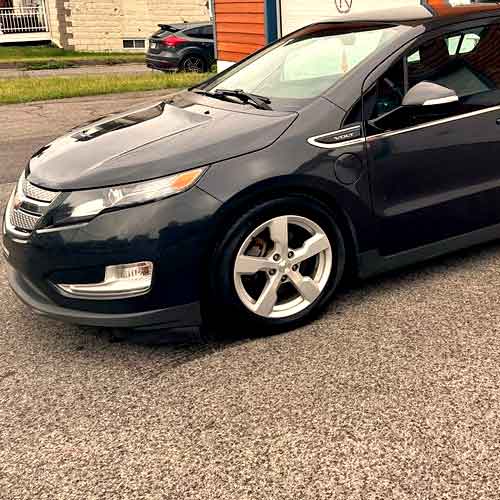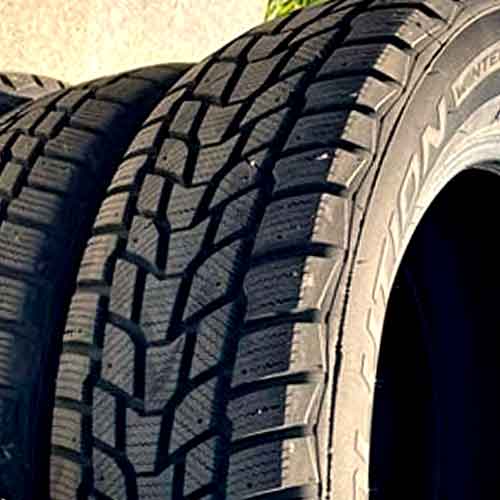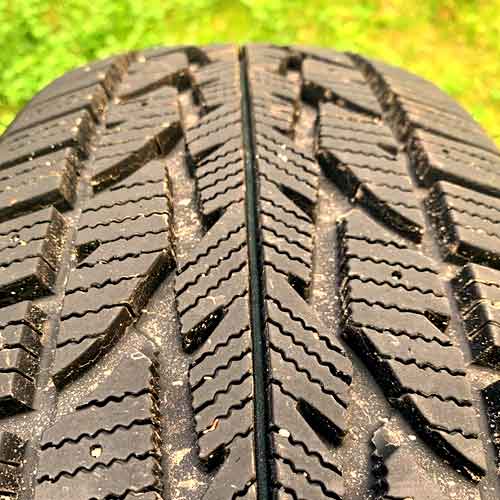The competition heats up as Cooper Evolution Winter, praised for its superior grip and comfort, squares off against Firestone Winterforce 2, known for its exceptional durability and handling. Let’s find out which tire can conquer the winter roads!

Table of Contents
Sizes Info
The Cooper Evolution Winter comes in 67 sizes in 14 to 20 inches, having following specs.
- Speed ratings: T and H.
- Load ratings: SL or XL.
- Tread depth: 12 and 14/32″.
- Weight: 17 to 37 lbs.
- Tread warranty: None.
On the other side, the Firestone Winterforce 2 (review) comes in 14 to 18″ with following.
- Speed ratings: S on all.
- Load ratings: SL and XL.
- Tread depth: 12/32″ on all.
- Weight: 15 to 35 lbs.
Longitudinal Traction
When talking about dry traction, we need to focus on two main parts: grip in a straight line, and handling around corners.
Now out of both, the Cooper Evolution Winter is better good at keeping its grip, or hold, on the road, as it’s designed with a slightly wider center, helping it to stay firmer on the road.

This means the tire can keep in close contact with the road, and can be used to explain why it showcases a shorter braking distance here of 3 feet, (on average).
On the other hand, the Firestone Winterforce 2 doesn’t do as well, with its wider gaps leading to a more limited rubber to surface contact.
Lateral Traction
Handling depends on two factors: contact from the shoulders and lug bending, and both of these aren’t favoring Firestone.
The Cooper Evolution Winter on the other hand, features a tighter shoulder pattern, which helps it grab the road better when moving sideways.
But why shoulders? Well, because they are the ones which bear the most weight, as the tire corners (mainly due to inertia).
And yes, worth reminding, the Cooper tire also features a relatively firmer lugs. Meaning, they don’t bend or flex as much as they do on Firestone.
And its significant, because excessive lug bending causes a delay steering response, which of course limits the overall handling abilities on a tire.
Ice Performance
In the realm of icy conditions, the Cooper Evolution Winter indisputably proves its dominance, showcasing an average braking distance that outperforms its counterpart by a considerable six feet.
And yes, the tire further impresses you with slightly superior acceleration as well, as seen in a range of tests.
So the question is, why does the Firestone fall short in these conditions? And the answer lies in the somewhat limited biting capability of that tire.
You see, the Winterforce 2 struggles due to its larger tread voids, diminished notches, and expanded lateral tread voids in the central tread area.

Such features, are although great on fluffier snow, they impede the overall efficiency when it comes to gripping on packed ice, resulting in compromised braking performance.
On the other side of the spectrum, the Cooper showcases a more aggressive siping that clenches the icy surface with, I have to say, impressive force.
The tire’s strategically angled biters dispersed across the tread, coupled with the dual siping (both rectilinear and lateral), collectively contribute to an relatively better ice-gripping experience, overall.
Fuel Economy
Fuel efficiency of a tire is intimately connected to its tread’s stickiness, and weight properties. And in these aspects, the Firestone Winterforce could certainly use an upgrade.
The weightier build (as seen on average, considering all sizes), and the tire’s larger tread voids, result in heightened lug flexing during cornering, braking, and acceleration.
This happens because each lug is bearing more weight pressure on itself, and the Winterforce’s wider grooves aren’t helping to that either.
This molding of the lugs asks for extra energy expenditure, that could have been used in to the rolling of the tire.
Conversely, the Cooper Evolution Winter, characterized by its more streamlined ribs and sleek design, demonstrates lower rolling resistance values, on average.
This indicates that the tire’s lugs aren’t compelled to apply as much force against the road. Thus, it allows the compact tread structure of the tire to devote its energy towards propelling the tire forward instead of expending energy on the bending of individual blocks.
Wet Traction
Wet traction is predominantly governed by two key elements: the tread design and the rubber compound incorporated into the tire. These variables determine the tire’s grip on damp surfaces and its resistance to hydroplaning. Let’s delve into each aspect further.
Wet Grip
Regarding wet grip, both tires are equipped with generous siping and pliable tread rubber. Nevertheless, the Cooper Evolution Winter still possesses an upper hand in grip, showcasing reduced slippage around corners.
So why is that? Well this tire adopts a dual siping design, incorporating a dense grid of straight and interlocking slits, all thoughtfully angled.
And this configuration offers grip from various directions.
Conversely, the Firestone Winterforce, armed solely with laterally aligned sipes, falls somewhat short in providing all-encompassing traction, which, predictably, results in elongated wet braking distances and handling times.
Resistance To Hydroplaning
Hydroplaning is a phenomenon where water obstructs the tire tread’s consistent contact with the road, causing a traction loss. And in this area, the Firestone Winterforce outperforms with its broader grooves.
Its wider channels, coupled with curving arms, quickly displace water from the tread, allowing higher average velocities, without hydroplaning in both straight-line and curved aquaplaning scenarios.
In comparison, the Cooper Evolution Winter lags due to its limited ability to evacuate as much water out, in a similar amount of time, as seen on its counterpart.
Fluffy Snow Performance
In snowy conditions, both tires yield admirable performance. However, when confronted with fluffier snow landscapes, the Firestone Winterforce 2 emerges as the top contender.
And this tire’s superior traction is primarily credited to its tread design.
Firestone essentially integrates a somewhat more aggressive tread pattern, featuring widely spaced lugs that engage with the snowy surface.
These tread blocks form a snow-to-snow contact, adeptly seizing and holding onto fluffy snow particles within their interlocking grooves and snow-vices.
This interaction fosters a layer of trapped snow, enabling the tread to sustain ground contact through this snow-filled rubber. This is significant because snow bonds more effectively with itself than with rubber, yielding increased friction.
In contrast, the Cooper Evolution adopts a more minimalist strategy, presenting a relatively sealed design with a continuous running rib at the center and missing an interlocking groove structure.
Hence, after thorough testing, we can confidently state that the Winterforce 2 demonstrates superior performance on fluffy snow terrains.
So, what’s the verdict?
In conclusion, both tires exhibit unique strengths that make them suitable for different conditions and requirements.
The Cooper Evolution Winter would be the preferred choice for icy conditions, dry traction, and fuel efficiency, while the Firestone Winterforce 2 is the ideal option for hydroplaning resistance and fluffy snow performance.
Ultimately, the decision rests on the user’s specific driving conditions and needs.